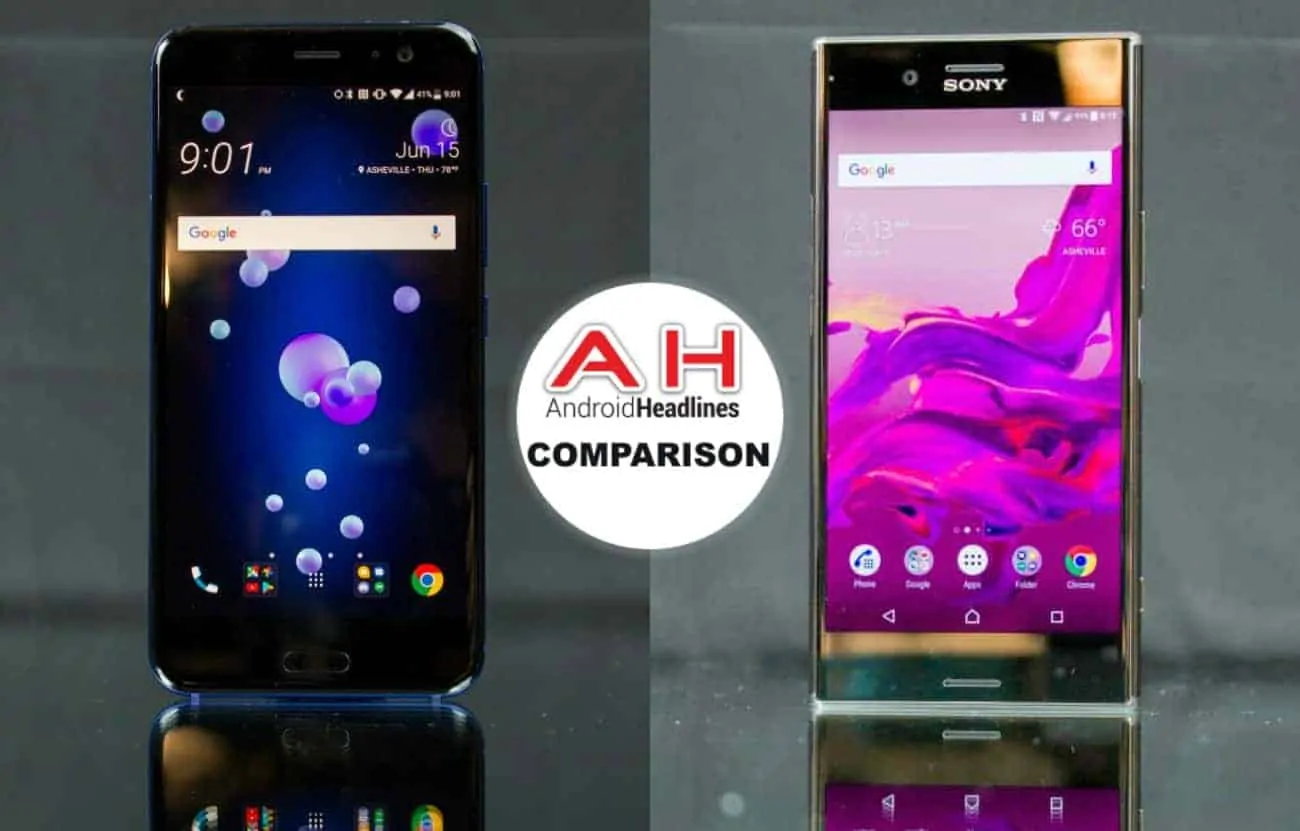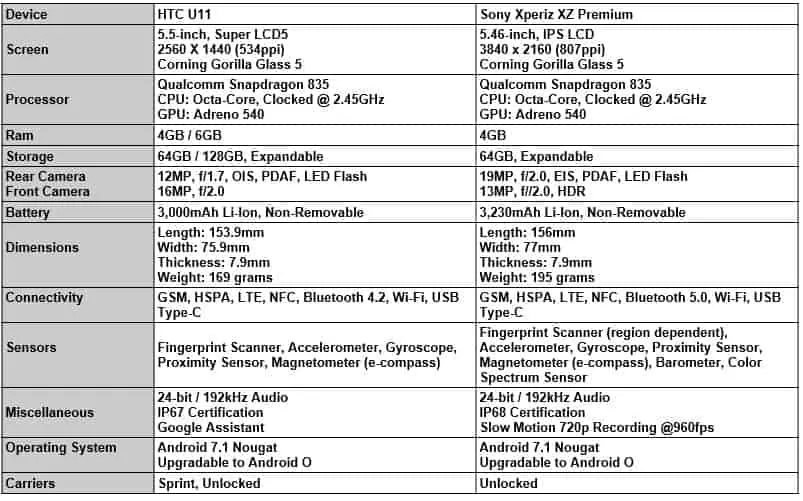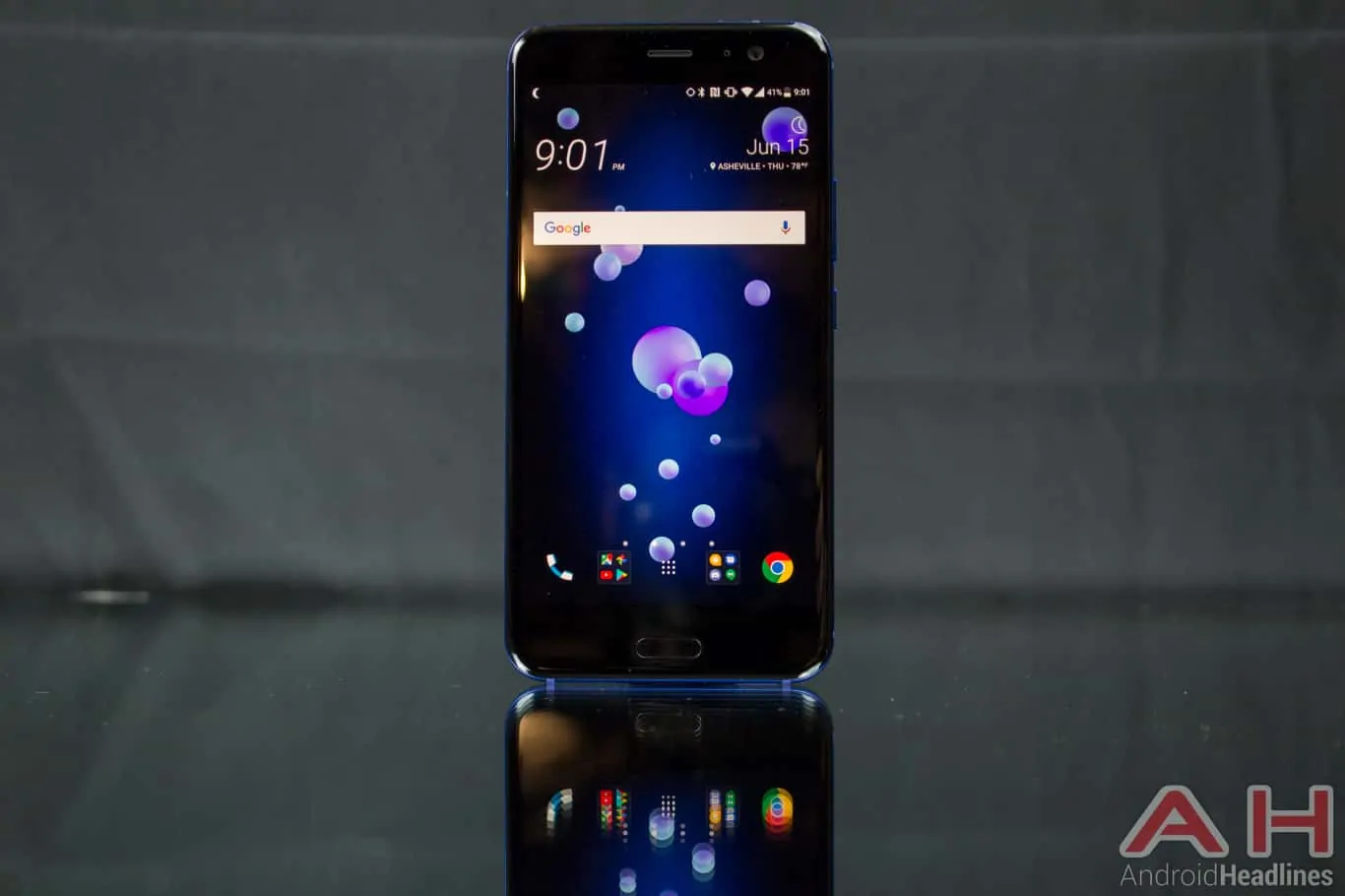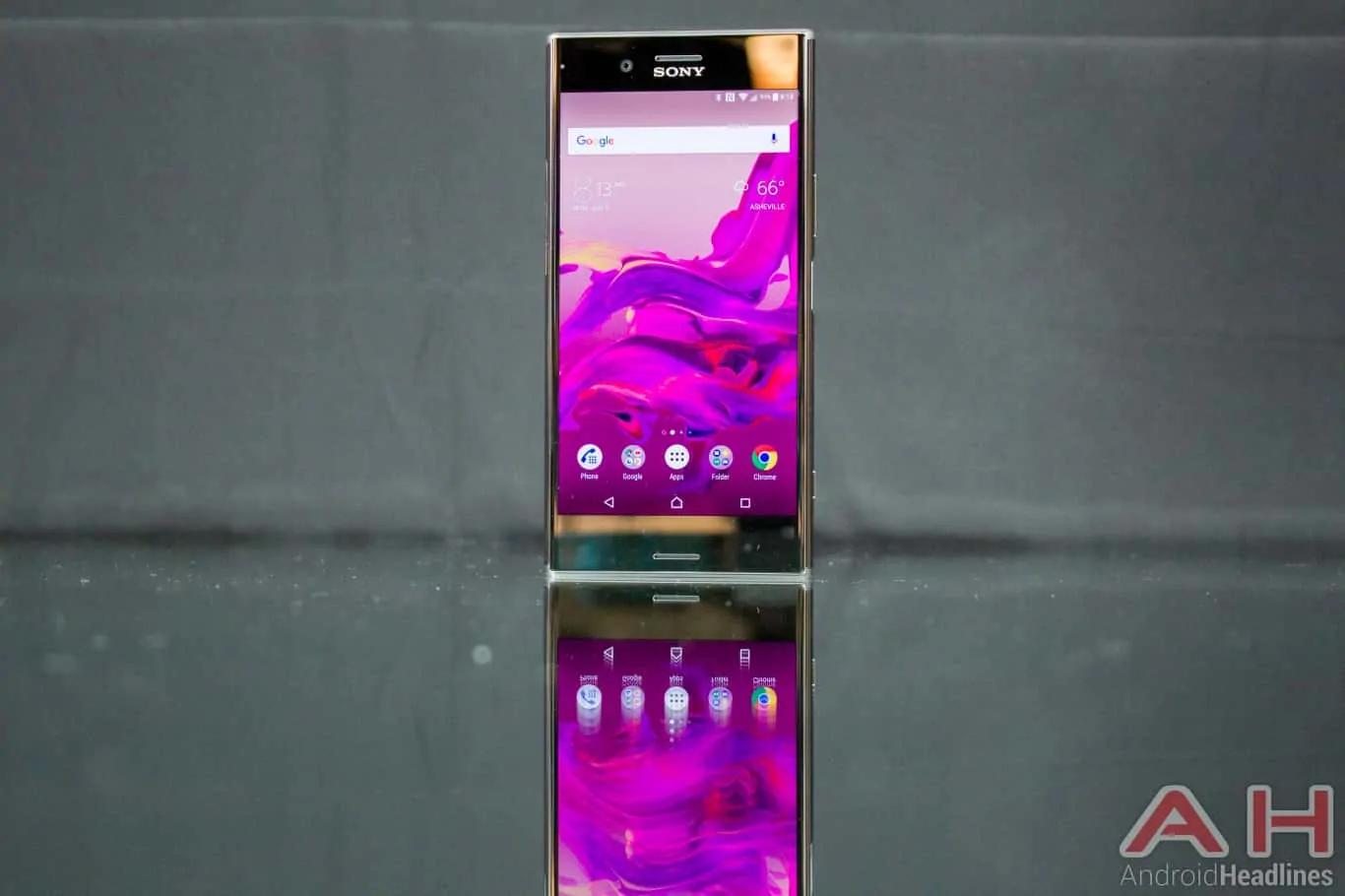Introduction
The Sony Xperia XZ Premium and the HTC U11 are two of the latest premium smartphones in the market, and today, we compare them side-by-side to see which one deserves your money and why. Both devices come from reputable manufacturers, and at least on paper, offer the very best hardware from top-tier vendors. However, while hardware is indeed a critical aspect of smartphones, it’s just the tip of the iceberg, with design, software, price and availability, all playing important roles in deciding which devices go on to become successful and which ones fall flat. That being the case, let’s take a detailed look at these two smartphones to find out which one is the better buy.
Specifications
HTC U11
The HTC U11 is the latest flagship smartphone from the Taiwanese company that has been suffering from some serious financial difficulty over the past couple of years, mostly on account of its dwindling smartphone market-share. The company, however, is banking heavily on the HTC U11 to change its fortunes and towards that end, is offering some really interesting features in the device, both in terms of its hardware and software. The first thing that strikes you when you look at the HTC U11 is the glossy ‘Liquid Surface’ design that gives it a distinctive look. The device follows the design language of earlier HTC launches like the U Ultra and U Play that saw the company switch from a metallic exterior to glass panels on the back. The HTC U11 is also the very first mainstream smartphone to ship with not one, not two, but as many as three AI-based virtual digital assistants out-of-the-box, namely, Google Assistant, Amazon Alexa and the company’s very own HTC Sense Companion.
However, that’s not nearly the end of the long list of enticing features HTC’s brand new smartphone offers its users. The device is also said to be the world’s first ‘squeezable’ smartphone, seeing as it ships with a unique feature called ‘Edge Sense’ that allows users to squeeze the sides of the device to interact with the phone in a number of different ways. The feature supports both long and short squeezes, and by default, launches Google Assistant with a long squeeze and fires up the camera with a short one. However, Edge Sense is customizable, so users can change what the squeezing does, which means you may assign any other app to your squeezes according to your choice. HTC is also expected to push through an update that will expand the Edge Sense functionality by enabling users to assign different functions to each squeeze depending on the app they’re in.
Taking a look at the hardware on the HTC U11, the device features a 5.5-inch WQHD (2560 x 1440) Super LCD5 capacitive touchscreen display that’s protected by Corning’s Gorilla Glass 5. It is powered by the Qualcomm Snapdragon 835 SoC which comes with an integrated CPU with eight custom Kryo 280 cores, four of which are clocked at 2.45GHz while four others run at 2.19GHz. An integrated Adreno 540 GPU takes care of all the graphics processing needs. The HTC U11 ships with 4GB of RAM and 64GB of built-in storage in the U.S., although, the company also offers a 6GB RAM + 128GB storage option globally. Both versions support microSD cards of up to 256GB in capacity. It also comes with a USB Type-C port for charging and data syncing, but like many of its competitors, misses out on the 3.5mm audio port. The handset ships with a 3,000 mAh Li-ion battery with support for Quick Charge 3.0, while sensors include a front-mounted fingerprint scanner integrated into the physical Home button, alongside an accelerometer, a gyroscope, a proximity sensor and a magnetometer (e-compass).
In terms of optics, the HTC U11 comes with a 12-megapixel primary camera with the company’s proprietary UltraPixel 3 and UltraSpeed Autofocus technologies. The camera has an f/1.7 aperture, a 1/2.55-inch sensor, phase detection autofocus (PDAF), optical image stabilization (OIS) and a dual tone LED flash. Software features include geo-tagging, touch focus, face detection, HDR and panorama. The camera can record 4K videos at 30fps and 1080p videos at up to 120fps. The front-facing selfie-cam on the HTC U11 is a 16-megapixel unit that can record 1080p videos at 30fps. The HTC U11 measures 153.9mm in length, 75.9mm in width and 7.9mm in thickness, while weighing in at 169 grams. The device also comes with an IP67 certification, which means it is also waterproof and dust-resistant.
Sony Xperia XZ Premium
The Xperia XZ Premium went on pre-order in the U.S. at Best Buy and Amazon earlier this week, and will be up for sale at these and many other retailers from June 19th. It is Sony’s latest flagship smartphone, and was announced way back at Mobile World Congress in Barcelona earlier this year. In fact, the device also won the title of the “Best New Smartphone at MWC 2017” at the annual Global Mobile (Glomo) Awards, so we’re dealing a true top-end smartphone that can take on anything in the market today. But then again, you’d expect nothing less from a company that has given us revolutionary gadgets like the Walkman and the PlayStation. As for the Xperia XZ Premium, the device, like its immediate predecessors, features a ‘Loop Surface’ design with smooth, rounded edges, but instead of the aluminum alloy called ‘Alkaleido’ on the back of the Xperia XZ, it comes with a glass back with Corning Gorilla Glass 5 protection. The top and bottom bezels of the device are made out of metal and have diamond-cut chamfered edges, which gives the phone a striking, yet elegant look.
The Xperia XZ Premium features a 5.46-inch IPS LCD Triluminous display covered with 2.5D curved glass. The panel comes with a 4K pixel resolution (3840 x 2160) and is protected with Corning Gorilla Glass 5. The device is powered by the same Snapdragon 835 SoC that powers the HTC U11 and, comes with 4GB of RAM and 64GB of internal storage that can be expanded by a microSD card of up to 256GB in capacity. Sensors on the Xperia XZ Premium include an accelerometer, a gyroscope, a proximity sensor, a barometer, a magnetometer (e-compass) and a color spectrum sensor, while cellular connectivity includes support for 4G LTE, 3G HSPA and 2G GSM. The device also features USB Type-C connectivity, but unlike the HTC device, it includes a 3.5mm audio port for compatibility with older headphones and audio systems. The Xperia XZ Premium is also fully waterproof and dust resistant, and comes with an IP68 certification, which means it can be submerged in up to 1.5 meters of water for up to 30 minutes at a stretch without any adverse effects. The device carries a non-removable 3,230 mAh Li-ion battery with support for Qualcomm’s Quick Charge 3.0, and comes with Android 7.0 Nougat pre-installed, but is expected to receive the Android O update at some stage going forward.
Finally, let’s take a look at the one aspect that makes or breaks a smartphone for many buyers – photography. The Xperia XZ Premium comes with a pair of really impressive cameras, including a 19-megapixel rear-facing image sensor with 5-axis electronic image stabilization (EIS), PDAF and laser autofocus along with the customary LED flash. The camera has an f/2.0 aperture, a 25mm focal length and a 1/2.3-inch sensor size, with software features that include geo-tagging, touch focus, face detection, HDR and panorama. The camera can record 4K videos at 30fps and super slow-motion 720p videos at an astounding 960fps, although, only for very short bursts of about 0.15 seconds. The front-facing camera is a 13-megapixel sensor that can record 1080p videos at 30fps and, comes with an f/2.0 aperture, a 22mm focal length, a 1/3-inch sensor size and 1.12µm pixel size.
So far, one would be inclined to think that there’s very little to choose from between these two devices in terms of their hardware components. However, the one thing that simply needs to be addressed before ending this comparison is the curious case of the missing fingerprint scanner in U.S.-bound units of Sony’s latest flagship. For some obscure reason not yet officially disclosed by the Japanese tech giant, all its recent smartphones have been shipping without fingerprint scanners – a standard biometric sensor that’s available even on $100 budget devices these days. Thankfully, though, international variants of the Xperia XZ Premium do ship with fingerprint scanners, but the company will still want to rectify this situation in the U.S. as soon as possible if its wants to be a major player in the country’s smartphone market any time soon.
… And The Winner Is …
The Final Word
Just like the Liquid Surface finish on the HTC U11, the Xperia XZ Premium’s Loop Surface is also glossy, shiny and super-reflective, and just like the HTC device, it also has a glass back with Corning Gorilla Glass protection. Add to that, all the similar hardware found on the two handsets, one might be excused for thinking that there’s very little to choose between the two devices. However, there are a couple of points that tip the scales decisively in favor of the U11. First and foremost – the plethora of new features on the HTC handset that makes it stand out from its competition. From Edge Sense to the trio of AI-based virtual assistants, the device offers a lot more in terms of user experience without lacking in any particular aspect. It also offers a fingerprint scanner and, comes with a $650 price-tag compared to the $800 you’ll need to cough up to get your hands on the Sony. Having said that, both the Xperia XZ premium and the HTC U11 are great devices that will not disappoint their users, but as things stand now, the HTC U11 just represents better value overall and that simply can’t be ignored.
Buy The HTC U11 Pre-Order The Sony Xperia XZ Premium




